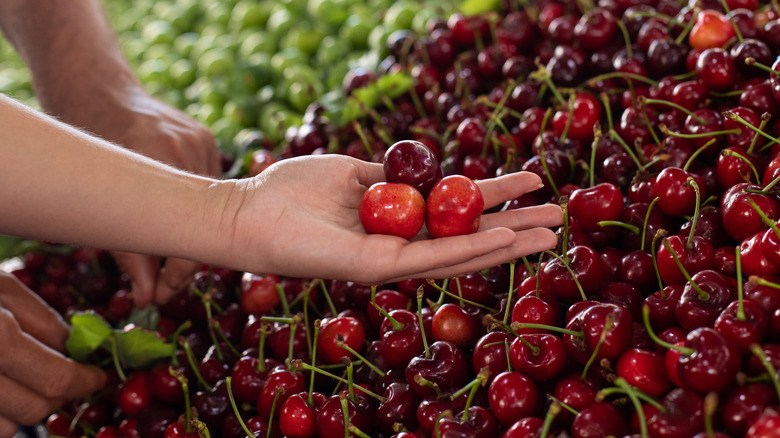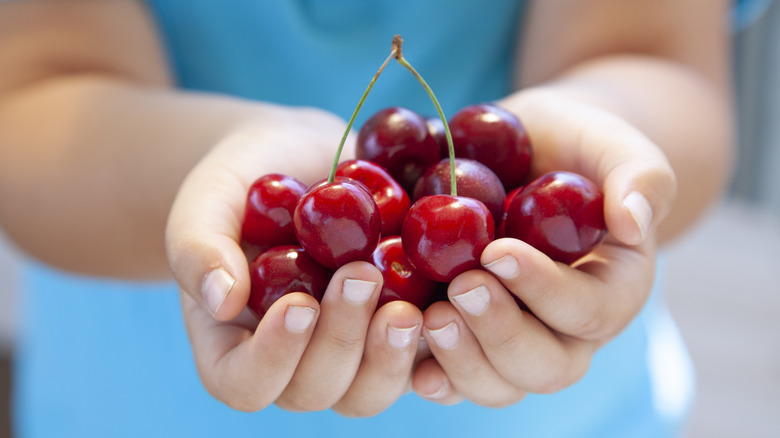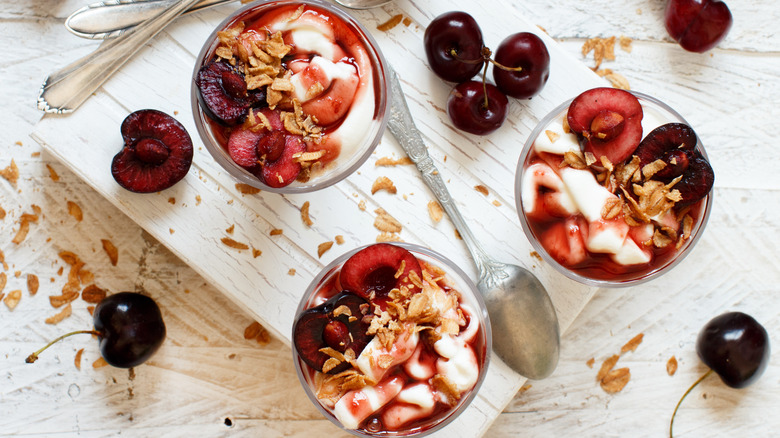The Rule-Of-Thumb You Should Know For Picking The Best Cherries At The Store
If life is a bowl of cherries, you probably want to make sure you're picking the best ones. Relying on your senses will help you do so, the most important being sight. When you're at the store, look for the best color and exterior; namely, dark and glossy.
While the hue will vary based on the cherry variety, generally a deep, red shade and a smooth, polished, well-saturated skin will be your indication the cherry is at its prime peak. A pale tone or any green means the cherry was picked too early. On the contrary, bruises, mold, and deflated, wrinkled spots indicate that the cherry is probably nearing its expiration.
Though, this changes slightly with the types of cherries you'll come across in the produce aisle. Most are sweet, like Bing, Chelan, and Rainier cherries. The best Bing cherries are a deep mahogany color. Chelan cherries, like Bings, are rich in color and are also called black cherries. The best Rainiers have some shades of yellow marking their lighter red skin.
Sour cherries, also known as tart cherries, are another kind of the fruit, but are usually found on store shelves in jars or in a dried form to snack on. When fresh, they tend to be a lighter shade of reddish-orange than their darker, sweet counterparts.
Touch the exterior and stem and taste them, too
Beyond visual cues, your other senses will also help you cherry-pick the best fruit. For example, get your hands in there and feel the cherries. Are they taught and tight and have a little give when you press on the skin? Do they easily squish in between your fingers? Or maybe they are rock-hard. The best cherries are plump and firm to the touch. Cherries tend to be more on the fragile side, so a gentle touch is all that is needed to determine if they are good.
You can also grab the stem to determine how fresh the flesh inside may be. The stem should be a healthy-looking green and not dried out or brown. If you pick up the cherry by it, the stem should remain intact. If it falls out easily, that means the opening left behind is more susceptible to rotting.
If all else fails, pop one in your mouth and taste it — that should be all you need to know about its ripeness. In general, cherries are in season from about late spring to mid-summer, with prime time being the month of July. Although cherries are enjoyable year-round, they are at their sweetest and juiciest during this peak season.
How to store and enjoy your well-chosen cherries
Fresh cherries only last a handful of days, even when they've properly stored in the refrigerator. You can stash them in a bowl, container, or in a bag with a paper towel to absorb excess moisture. The goal is to keep them chilled and loosely packed to allow for airflow.
If you're unable to make it through the bunch before they begin to spoil, freezing is always an option — and an excellent way to enjoy them at their peak all year. Rinse, stem, and pit them, then spread them out on a baking sheet or tray in the freezer, ensuring none are touching. Once frozen, you can transfer them to a bag or container.
If you're ready to use your perfect cherries right away, there are some things to know about how to use the different varieties. Sweet cherries are best enjoyed fresh, so toss them into yogurt, salad, and no-bake desserts, or whip up a chutney to add a touch of sweetness atop freshly grilled fish, chicken, or meat. You can also try adding them to a mixed drink for a fresh spin on the maraschino cocktail, or bake up a batch of cherry turnovers.
Sour cherries usually found jarred or canned are best for pie fillings and other year-round treats. They can withstand higher heat better than sweet cherries, so if you find them fresh, add a sweetener and go to town making fresh jams, jellies, desserts, and baked goods like sour cherry cheesecake bars.



